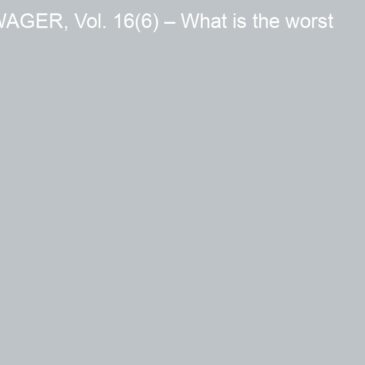It is important to understand clinical characteristics (e.g., betting pattern, emotional states, gambling preferences) of pathological gambling to provide insight for developing effective prediction, prevention and treatment initiatives. This week’s WAGER reports results of a study that examined how gambling preferences (i.e., strategic versus non-strategic) relate to clinical characteristics among people who suffer with gambling disorder (Odlaug, Marsh, Kim, & Grant, 2011).
Method
- Participants (N = 440, age >=18, 54% females) were patients with a current DSM-IV diagnosis of pathological gambling (PG) and no psychotic or bipolar disorders. The researchers recruited participants who were enrolled to one of several clinical trials that investigated PG treatment during 2000 through 2008.
- Investigators assessed participants using the following measures:
- Psychiatric assessment – The Structured Clinical Interview for DSM-IV Axis Disorders (SCID-I; Williams et al., 1992) and the Structured Clinical Interview for Pathological Gambling (SCI-PG; Grant, Steinberg, Kim, Rounsaville, & Potenza, 2004).
- Demographics and features of PG – The researchers assessed participants’ gender and age. The semi-structured clinical interview asked for the preferred types of gambling.
- PG symptoms severity – The Yale-Brown Obsessive Compulsive Scale Modified for Pathological Gambling (PG-YBOCS; Pallanti, DeCaria, Grant, Urpe, & Hollander, 2005) and the Clinical Global Impression Severity scale (CGI-S; Guy, 1976).
- Based on the participants’ reported preferred gambling type, the researchers assigned participants to one of three groups: strategic gamblers (e.g., those who prefer poker, blackjack, dog and horse racing, sports betting, and craps/dice games; N =56); nonstrategic gamblers (e.g., those who prefer slot machines, pull tabs, bingo, and keno; N = 200); and, both (those who reported no preference; N = 184).
Results
- Table 1 shows that the nonstrategic gamblers reported no more relationship, financial or work-related problems than strategic gamblers.
- The nonstrategic gamblers were older than strategic gamblers when they started gambling (mean age 34.1 vs. 22.5) and when gambling became a problem (mean age 42.6 vs. 30.6). Nonstrategic gamblers were also less educated (60.4% with at least some college education vs. 79.6%) and more likely to be women (71.5% vs. 30%) than strategic gamblers. All differences are statistically significant at p < .01.
- There were no differences between the groups in terms of PG symptoms severity and psychiatric comorbidity.
Table 1. Self-reported gambling related problems among gamblers who prefer strategic, nonstrategic and both types of gambling – N (%)
|
Group Problems due to gambling |
Nonstrategic N = 200 |
Strategic N = 56 |
Both N = 184 |
|
Financial |
151 (75.5) |
40 (71.4) |
153 (83.2) |
|
Relationship |
37 (18.5) |
4 (7.1) |
23 (12.5) |
|
Work-related |
92 (46.0) |
20 (35.7) |
79 (42.9) |
Note: These are the measures with no significant difference between groups.
Limitations
- This is a self-reported study. The self-reported preference to play a specific type of game might not identify the game type that is associated with problems or is actually the most often played game.
- The study included only treatment seeking gamblers.
Conclusion
The study found that gambling type preference is confounded with age, education, and gender differences. Specifically, gamblers that prefer nonstrategic games are older, less educated, and more likely to be women than those that prefer strategic games. However, because female gamblers tend to be older than male gamblers (Nelson, LaPlante, LaBrie, & Shaffer, 2006) further studies should examine if the age and education differences remain when the gender is controlled. The study did not find differences in the severity of PG symptoms among the groups. However, using treatment-seeking PGs as participants necessarily reduces the variance in symptom severity, and might work against finding differences in associated measures.
-Julia Braverman
What do you think? Please use the comment link below to provide feedback on this article.
References
Grant, J. E., Steinberg, M. A., Kim, S. W., Rounsaville, B. J., & Potenza, M. N. (2004). Preliminary validity and reliability testing of a structured clinical interview for pathological gambling. Psychiatry Res, 128(1), 79-88.
Guy, W. (1976). ECDEU assessment manual for psychopharmacology. Rockville, MD: US Department of Health, Education and Welfare publication (ADM).
Nelson, S. E., LaPlante, D. A., LaBrie, R. A., & Shaffer, H. J. (2006). The Proxy Effect: Gender and Gambling Problem Trajectories of Iowa Gambling Treatment Program Participants. Journal of Gambling Studies, 22(2), 221-240.
Odlaug, B. L., Marsh, P. J., Kim, S. W., & Grant, J. E. (2011). Strategic vs nonstrategic gambling: characteristics of pathological gamblers based on gambling preference. Ann Clin Psychiatry, 23(2), 105-112.
Pallanti, S., DeCaria, C. M., Grant, J. E., Urpe, M., & Hollander, E. (2005). Reliability and validity of the pathological gambling adaptation of the Yale-Brown Obsessive-Compulsive Scale (PG-YBOCS). J Gambl Stud, 21(4), 431-443.
Williams, J. B., Gibbon, M., First, M. B., Spitzer, R. L., Davies, M., Borus, J., et al. (1992). The Structured Clinical Interview for DSM-III-R (SCID). II. Multisite test-retest reliability. Arch Gen Psychiatry, 49(8), 630-636.





Terri July 6, 2011
As a “PG” woman, I found your study interesting. I related to the age I started gambling compulsively, (I was 41) and I’ve found that I suffered the same problems from my gambling as others in my recovery path. I agree and support the suggestion to look at just the female gamblers to see if their starting age is higher…my recovery experience says that it is higher for non-strategic gambling women. I don’t agree, however, that education is a factor in whether someone is strategic or non-strategic. I think that’s a factor based more on personality and ego than on education…again based on my active gambling experience and my recovery experience.
Thanks!